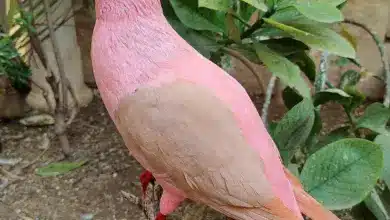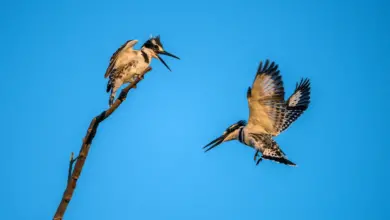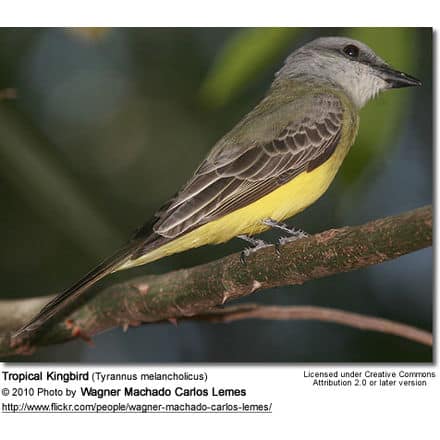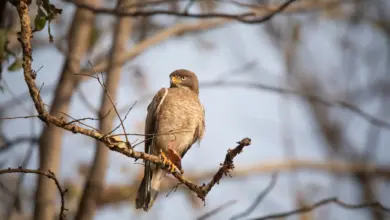The European Nightjar (Caprimulgus europaeus) – also known as Common Nightjar, Eurasian Nightjar, or simply Nightjar – is the only nightjar found in most of Europe and temperate Asia.
The nightjar or goatsucker family was named such as they were once believed to drink a nanny’s goat’s milk during the night (the Latin word for goat-sucker or goat-milker is Caprimulgus).
In the past, night-flying birds – such as the nightjars – were suspected of witchery.
They blend into their environment quite perfectly thanks to their cryptic appearance. During the day, they are usually sleeping in a concealed place. At night, they are more easily detected – often when light from car headlights is reflected red from their eyes, as they are sitting on roads or tracks. Their presence is most often made known by their loud calls given at dusk.
These nightjars are commonly heard within their range, but less often seen – due to their nocturnal habits. The brown-mottled plumage keeps them well camouflaged during the day.
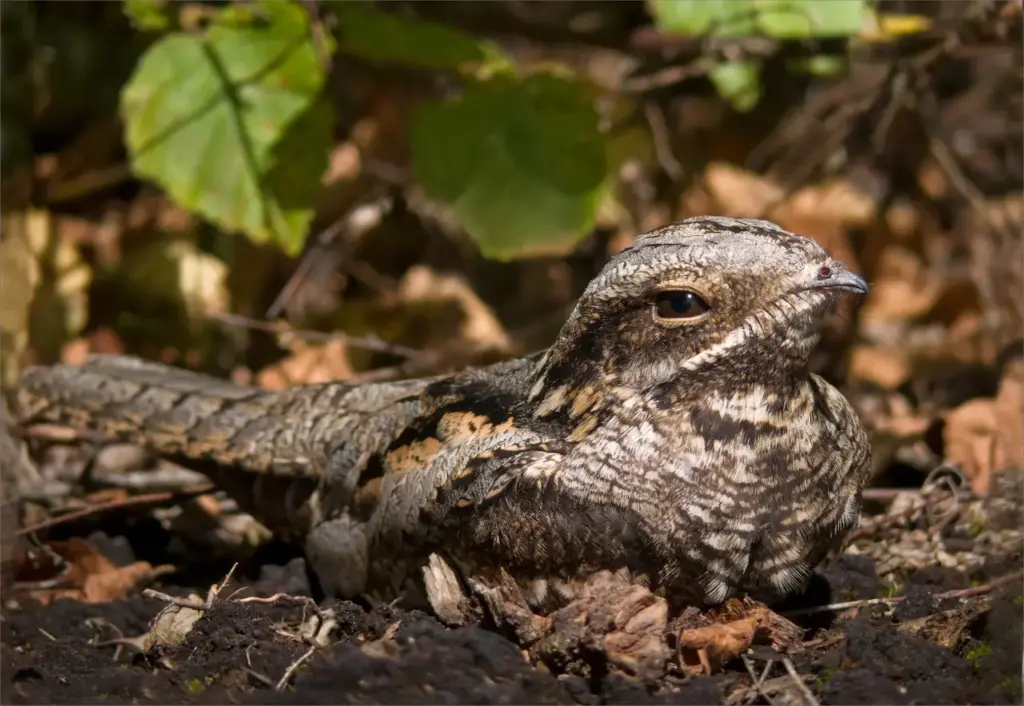
Alternate (Global) Names
Afrikaans: Europese Naguil … Albanian: Dallëndyshe nate, Dallëndyshe natë … Arabic: ????? ????????, ????????, ???????? ???? ??????? … Armenian: [Sovorakan Aytskit ], ????? , ????????? ?????? … Asturian: Paparrosolla … Azerbaijani: Adi keçisa?an … Basque: Enganyapastors, Zata arrunt, Zata arrunta … Belarusian: ???????? ????? … Bulgarian: ??????? … Breton: An adren Europa … Catalan: Enganapastors, Enganyapastors … Chinese: [Ou ye-ying], [Ou-ya ye-ying], [Ouzhou ye-ying], ????, ???, ???? … Cornish: Troyller … Croatian: Leganj, Leganj mra?njak … Czech: Lelek lesní … Danish: Natravn … Dutch: Nachtzwaluw … Esperanto: eûropa kaprimulgo, E?ropa kaprimulgo … Estonian: Öösorr … Finnish: Kehrääjä … Faroese: Náttkjarra … French: Engoulevent d’Europe, Engulevent d’Europe … Gaelic: Sgraicheag Oidhche … Galician: Avenoiteira cincenta, Enganyapastors … Georgian: ??????????? ???????????, ??????????? ??????? … German: Nachtschwalbe, Ziegenmelker, Ziegenmelker 7 Nachtschwalbe … Greek: (?????????) ????????, ???????? … Hebrew: ???? ???????, ???? ?????? … Hungarian: Lappantyú … Irish: Tuirne Lín, Túirne lín … Icelandic: Náttfari … Italian: Succiacapre, Succiacapre eurasiatico, Succiacapre europeo … Japanese: yoaroppayotaka, yo-roppayotaka, Youroppa yo-taka … Khakas: ???????, ???? ???????, ???????? ??? … Kazakh: ??????? ????????? … Kwangali: Rumbamba … Lithuanian: L?lis, Lelys, L?lys, Naktiny?ia … Latvian: L?cis, L?lis, L?pis, Vakarl?pis … Macedonian: ???????, ????? ????????? … Maltese: Buqrajq … Manx: Screeaghag oie, Ushag ny Hoie … Mongolian: ????? ??? … Norwegian: Kveldknarr, Nattravn … Polish: lelek, lelek (zwyczajny), Lelek kozodój, Lelek zwyczajny, Wlochatka, W?ochatka … Portuguese: Noitibó, Noitibó da Europa, Noitibó-da-europa… Romansh: Chavret … Russian: Obyknovenny Kozodoy, ??????? ????????????, ???????????? ???????, ???????????? ??????? – ??????? … Scots: Sgraicheag oidhche … Slovak: lelek lesný, lelek lesný/lelek oby?ajný, Lelek oby?ajný … Slovenian: legen, podhujka … Shona: Datiwa … Serbian: kozodoj, leganj, leganj mracnjak, leganj mra?njak, Prileguša, Prileguša, leganj, kozodoj, ??????j, ???????, ?????, ?????j, ?????????, ?????????, ????????? … Sotho, Southern: Semanama … Spanish: Chotacabra Gris de Europa, Chotacabras Europeo, Chotacabras Gris, Chotacbras Gris … Swedish: Nattskärra … Swahili: Kirukanjia wa Ulaya … Tswana: Leubauba … Turkish: Çobanaldatan … Tsonga: Mahulwana … Tuvinian: ??? ????, ?????? ????, ?????????, ????-???? … Ukrainian: ???????? … Welsh: Aderyn y dröell, Aderyn-yr-eira, Brn y nos, Gafr, Gafr y gors, Gwalch y nos, Gwennol y nos, Rhodor, Troellwr, Troellwr mawr, Wil nyddwr … Xhosa: Udebeza … Zulu: uZavolo
Habitat and distribution
The European Nightjar breed throughout northern and central Europe and migrate south to winter in Africa, as far south as the southern tip of Africa (Cape).
They usually start leaving for their wintering grounds in August and by the middle of September, most of them have left. They return to their breeding territories at the end of April or the beginning of May.
They occur in open bracken-covered slopes and open woods.
Description
European Nightjar measure about 10 inches (26 cm) in length (including the tail) and have a wingspan of about 22 inches (55 cm).
The adult European Nightjar’s plumage is lichen-grey, barred, and streaked with buff, chestnut, and black. The under plumage is barred. The bill is black and the legs are reddish brown.
The male can be identified from the female by the white spots on the primaries (= longest wing feathers) and white tips to the outer tail feathers. These markings are buff in juvenile males.
Calls / Vocalizations
They are mostly silent, except for a croak of alarm when nearly stepped on.
Its song is described as soft, mechanical sounding, churring trills that rise and fall. During its song, the lower beak vibrates and the throat is distended until the feathers stand out.
In flight, it has a soft call, and a sharper and repeated alarm call, cuick, cuick.
Feeding / Diet
The European Nightjar mostly feed near dawn and dusk (crepuscular – active during the twilight). At dusk, they often fly around livestock to feed on insects swarming around the animals. At night, they like to take advantage of insects swarming around street lamps or other artificial light sources.
The European Nightjar may also forage under the canopy by flying from favored perches catching insects at foliage heights of 5 – 15 feet (~1.5 – 5 m). Larger insects are usually taken back to their favored feeding perches. While holding the insects in their bills, nightjars keep their heads upright, shake and swallow the prey whole, or they may break the insects apart before eating. Insects may also be taken from the ground or foliage. Juvenile nightjars typically sit on the ground before making short jumps or flights to capture insects.
The bulk of their diet consists of flying/swarming insects, such as mosquitoes, flies, beetles, locusts, winged ants, moths, and grasshoppers as well as plant lice and crickets.
They capture insects mid-air with their large, 2-inch wide, gaping mouths, and swallow them whole. To a lesser extent, they will also eat larvae, nymphs, and eggs.
They drink while flying slowly over a water surface scooping up water with their wide beak.
Like other nightjars, they have special physical adaptations that facilitate foraging at night and catching prey in mid-air, for example:
- The beak has evolved to be much wider than it is long, and it opens wide both – vertically as well as horizontally. The resulting big gaping mouth allows it to more easily scoop up insects in flight.
- Its large eyes are placed on each side of the head (laterally) – which significantly increases its visual field.
- A reflective membrane behind the retina (tapetum) enhances its vision at night by augmenting the light-gathering ability of its eyes.
- They also have forward-facing whiskers that may either help them funnel food into the mouth or protect the eyes.
Reproduction / Nesting
The European Nightjar breeding season usually commences at the end of April or the beginning of May. The eggs are usually not laid before the end of May.
The male establishes his territory and sings at night to keep rivals away and at the same time to attract a female.
As part of his courtship ritual, the male will produce a mechanical signal – a sharp cracking sound – by clapping the wings together over the back.
Nightjars don’t construct a nest, as most other bird species do. They simply place the eggs on the ground on bare ground amongst bracken or stones.
Nesting appears to be timed in such a way that the moon is more than half full at the time they are feeding their young – likely as the additional light during the night facilitates caring for the young and foraging for food.
The female may lay one to two eggs (mostly two) that are oval, creamy in color, with brown, purple, and liver-colored spots or blotches.
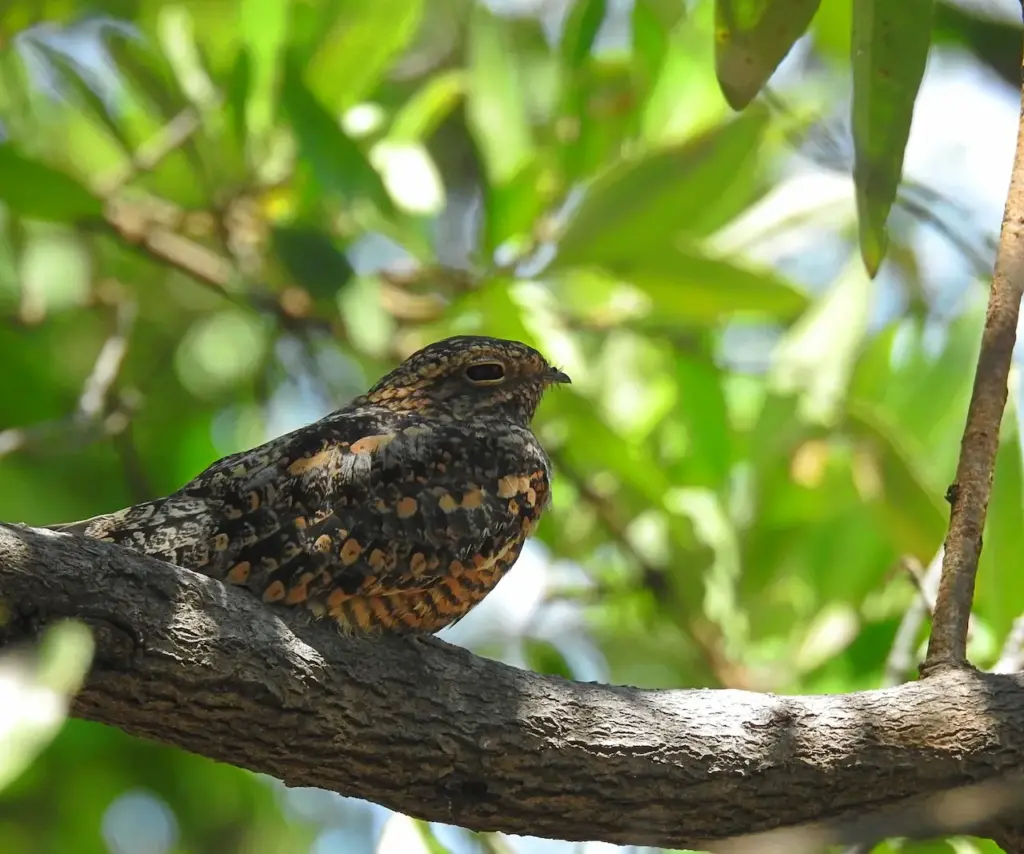
During the day, the incubation of the eggs is mostly undertaken by the female, while both parents share the incubation at night. The incubation period is about 19 to 21 days. If disturbed, the female will “squatter” away to attract the attention of any potential predators, rolling and fluttering in a frenzy.
The hatchlings are covered in grey and brown with vivid blue skin showing on the back of the neck (nape) and back. They are capable of short-distance movements within 24 hours of hatching. They usually move apart shortly after hatching, maybe to make it more difficult for predators to spot them. The parents also shove them apart with their feet as they flush from the nest. The male usually stands guard and defends the nest and the young.
Both parents feed the young regurgitated food (insects), and they continue to brood them until they fledge. The young take their first flight when they are about 20 to 21 days old.
If conditions are favorable, the female may lay a second clutch close to the first and while she is incubating the new set of eggs, the male continues to care for the young from the first brood.
They have developed several behavioral adaptations to minimize predation:
-
- Their nocturnal (night) lifestyle reduces the likelihood of being detected by daytime predators. During the daytime, they typically sleep on the ground where they are perfectly camouflaged by their “earthy” colored plumage. They almost always change their roost sites daily.
- When nesting, they sit quietly on the eggs, minimizing any movements that could get them detected.
- If an intruder does get close to the nest, the parents may try to lead them away by first flushing off the nest and when landing feigning injury as they lead the potential thread away from the nest. While the parent performs this distraction display, the young may scatter and freeze.
- The parent who is not incubating the eggs or brooding the young will roost away from the nesting area.
- They may also move the eggs or young to prevent them from being preyed upon.
- Nightjars avoid voicing when they hear the calls made by predatory nocturnal animals, such as owls.

